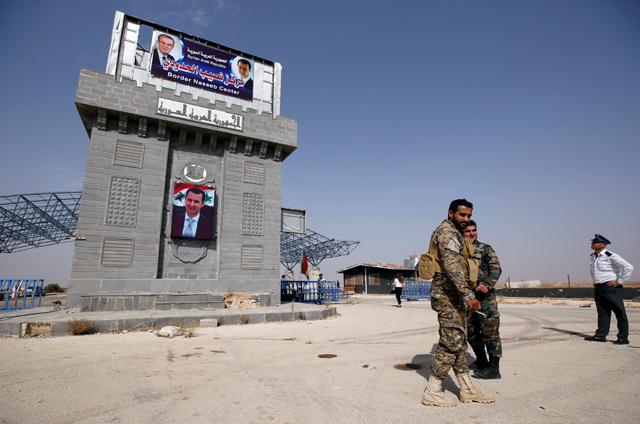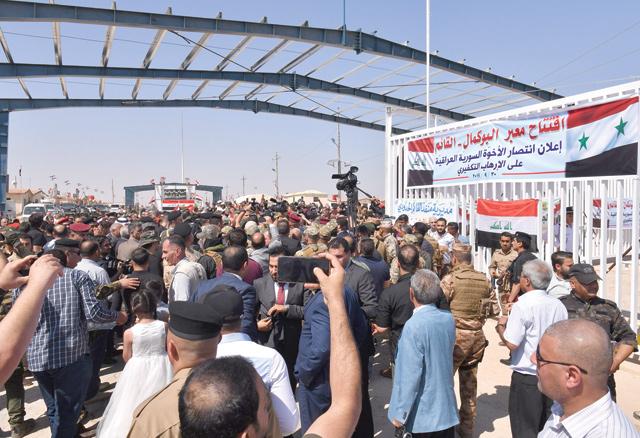You are here
Syria reopens two border crossings, but many escape regime control
By AFP - Oct 15,2018 - Last updated at Oct 15,2018

Syrian army soldiers are seen at the Nasib border crossing with Jordan in Deraa, Syria, on Monday (Reuters photo)
BEIRUT — Two border crossings in Syria's south reopened on Monday, after the government's capture of the entire frontier there allowed for the gates to be opened for the first time in years.
Of Syria's 19 border points with Lebanon, Jordan, Iraq, and Turkey, the regime now controls more than half, including all of those with Lebanon, two each with Jordan and Iraq and two closed crossings with Turkey.
Syria shares two border crossings with Jordan.
The Nassib border crossing point lies in the southern province of Daraa. It was overrun by rebels in April 2015 but government troops recaptured it in July. It was reopened by the Jordanian and Syrian authorities on Monday, in hopes the vital trade route passing through it would be revived.
The former Daraa customs post was recaptured by the regime during its summer offensive on the south, ending five years of rebel rule there, along the Jordanian borderline area of Ramtha.
On the northern border with Syria, there are nine border crossings with Turkey.
Kassab, in the western province of Latakia, had remained under regime control but closed by Turkey since fierce clashes broke out in 2014 between the army and Islamist rebels, who briefly overran the post.
Northwest of Idlib, the Bab Al Hawa crossing is still held by Islamist rebels, including an alliance dominated by Syria's former Al Qaeda branch.
Meanwhile, in Aleppo, the Bab Al Salama and the Jarabulus crossing points are still held by Turkish-backed Syrian rebels, while the Kobane crossing is held by US-backed Kurdish fighters since 2015, who also hold the Tal Abyad crossing there and the Ain Diwar in Hasakeh.
Northeast of the Hasakeh province, the Ras Al Ain crossing saw the site of ferocious battles between Daesh and Kurdish fighters before the latter forced the terrorists out of the post and nearby town.
The only regime controlled crossing in the Hasakeh province is the Qamishli point, but it remains closed on the Turkish side.
As for the border with Iraq, each of the three crossings is controlled by a different party to the conflict.
The Yaarubiya-Rabia crossing in Hasakeh is controlled by Kurdish fighters, while the Albu Kamal crossing in the eastern province of Deir Ezzor, is held by regime forces and allied regional militiamen who seized it from Daesh in 2017.
East of Deir Ezzor, Al Tanaf crossing held by US-led coalition forces and allied fighters who seized it from Daesh. Iraqis call it Al Walid.
The Iraqi and Syrian authorities announced on Monday the Al Qaim crossing with Iraq qill also be opened imminently.
Known as Al Qaim on the Iraqi side. Iraqi and Syrian authorities announced Monday its reopening was "imminent".
All five crossings with Lebanon, leading into Homs and Damascus provinces in Syria, are controlled by government forces. They are Jdeidet Yabus-Masnaa, Dabussiyeh-Abbudiye, Jussiyeh-Al Qaa, Tal Kalakh-Bouqueiya, and Tartus, known in Lebanon as Al Arida.
As for the southeastern borders, the Quneitra crossing which connects Syria with the Israeli-occupied Golan are still under the control of UN Disengagement Observer Force, but was closed in 2014 when rebels over ran it.
There are no formal crossings between Syria and Israel, who are officially still at war.
With the Syrian government's recapture of Quneitra, the crossing was reopened on Monday under an agreement between Syria, Israel, and the UN.
All sea ports on Syria's Mediterranean coast are controlled by the regime.
Related Articles
AL QAIM, Iraq — A border crossing on a vital highway linking the capitals of Iraq and Syria, seized by the Daesh terror group in 2014, reope
BEIRUT, Lebanon — The capture of Eastern Ghouta is a significant milestone for Syria's regime and paves the way for government troops to shi
SHADADI, Syria — A senior US diplomat visited Kurdish-held territory in Syria on Saturday as the minority faction negotiates with Damascus o

















